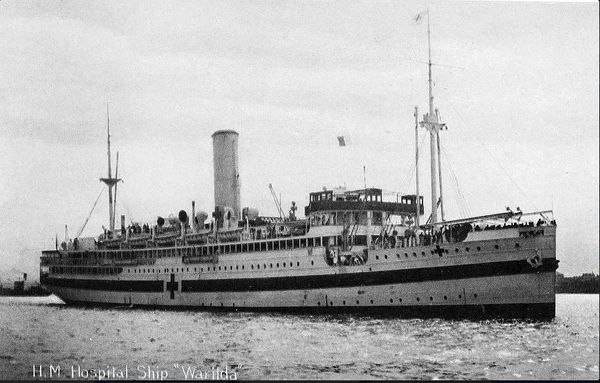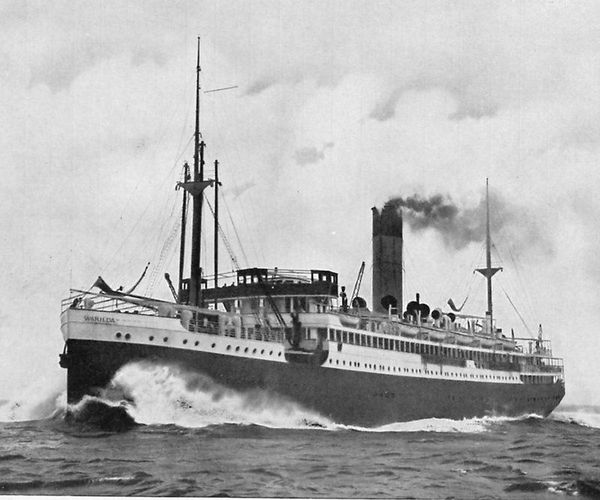Difference between revisions of "HMAT A69 Warilda"
From Our Contribution
| Line 9: | Line 9: | ||
| shipyardnumber = 505 | | shipyardnumber = 505 | ||
| shiplaunched = 5 Nov 1911 | | shiplaunched = 5 Nov 1911 | ||
| − | | shipcompleted = 1912 | + | | shipcompleted = 1912 |
| − | | shipinservice = | + | | shipinservice = 1912 |
| − | | shipoutofservice = | + | | shipoutofservice = 1918 |
| shipinservice2 = | | shipinservice2 = | ||
| shipoutofservice2 = | | shipoutofservice2 = | ||
| Line 28: | Line 28: | ||
==Remarks== | ==Remarks== | ||
| − | Built for the Adelaide Steamship Company. | + | Built for the Adelaide Steamship Company. Commenced passenger services out of Fremantle, Western Australia upon arrival in 1912. Capable of almost 400 passengers in three classes. She was converted into a troopship in August 1915 and made three journeys from Australia in this form. Converted again in 1916, this time to be a Hospital Ship controlled by the British Admiralty and she served as such from 25 Jul 1916 till 3 Aug 1918 on the Southampton-Le Havre run. |
| − | On 3rd August 1918 while transporting | + | On 3rd August 1918 while transporting about 700 sick and wounded men from Le Havre to Southampton, the ''HS Warilda'' was torpedoed and sunk by the German submarine UC-49. This was despite being marked clearly with the Red Cross; as with a number of other hospital ships torpedoed during the war, Germany claimed the ships were also carrying arms. |
| − | The ship sank in about two hours, and of the 801 persons on board, 123 people perished including 19 Australians and the Deputy Chief Controller of the Queen Mary’s Army Auxiliary Corp, Mrs Violet Long. Those lost at sea in the Channel are commemorated on the Hollybrook Memorial, Southampton. | + | The ship sank in about two hours, and of the 801 persons on board, 123 people perished including 19 Australians and the Deputy Chief Controller of the Queen Mary’s Army Auxiliary Corp, Mrs. Violet Long. Those lost at sea in the Channel are commemorated on the Hollybrook Memorial, Southampton. |
==Medical Staff== | ==Medical Staff== | ||
Latest revision as of 15:51, 13 October 2021
Contents
- 1 Remarks
- 2 Medical Staff
- 3 Soldiers carried
- 3.1 Fremantle to Port Tewfik 16 February - 13 March 1916
- 3.2 Fremantle to Plymouth 1 June - 18 July 1916
- 3.3 France to England 28 Jan 1917
- 3.4 Rouen to England 8 March 1917
- 3.5 Le Havre to England 3 May 1917
- 3.6 France to England 25 May 1917
- 3.7 France to England 25 September 1917
- 3.8 France to England 14 October 1917
- 3.9 France to England 14 March 1918
- 3.10 France to England 31 May 1918
- 3.11 Other Voyage
Remarks
Built for the Adelaide Steamship Company. Commenced passenger services out of Fremantle, Western Australia upon arrival in 1912. Capable of almost 400 passengers in three classes. She was converted into a troopship in August 1915 and made three journeys from Australia in this form. Converted again in 1916, this time to be a Hospital Ship controlled by the British Admiralty and she served as such from 25 Jul 1916 till 3 Aug 1918 on the Southampton-Le Havre run.
On 3rd August 1918 while transporting about 700 sick and wounded men from Le Havre to Southampton, the HS Warilda was torpedoed and sunk by the German submarine UC-49. This was despite being marked clearly with the Red Cross; as with a number of other hospital ships torpedoed during the war, Germany claimed the ships were also carrying arms.
The ship sank in about two hours, and of the 801 persons on board, 123 people perished including 19 Australians and the Deputy Chief Controller of the Queen Mary’s Army Auxiliary Corp, Mrs. Violet Long. Those lost at sea in the Channel are commemorated on the Hollybrook Memorial, Southampton.
Medical Staff
Fremantle to Plymouth 1 June - 18 July 1916
Soldiers carried
Fremantle to Port Tewfik 16 February - 13 March 1916
Fremantle to Plymouth 1 June - 18 July 1916
Left Melbourne 25 May 1916
France to England 28 Jan 1917
Rouen to England 8 March 1917
Le Havre to England 3 May 1917
France to England 25 May 1917
France to England 25 September 1917
France to England 14 October 1917
France to England 14 March 1918
France to England 31 May 1918
Other Voyage
- 5 Oct - 5 November 1915 Brisbane to Port Tewfik, Egypt
15th Battalion and reinforcements for 9th Battalion.
1Oth reinforcements for 1st Battalion embarked in Sydney on 8 October.

